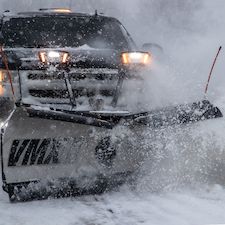Equipment Insight – Attachments
Attachments can multiply the versatility of equipment; experts share how rental centers can get the best ROI from their attachment investment.
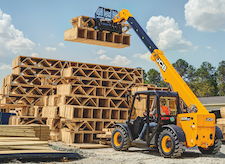 |
|
Machines are limited by the lowest common capacity; consider a telehandler that has a carriage with a 12,000-pound capacity.
|
|
|
|
There is a movement to increasingly simple mounts that are designed to be used by just about anyone without a lot of effort or alignment to install it, reports Scott Moorman of Buyers Products. |
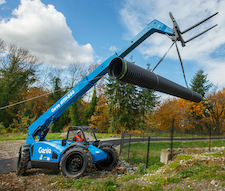 |
| Telehandler fork attachments outfitted with hooks or clevises allow users to lift awkward loads safely and efficiently. |
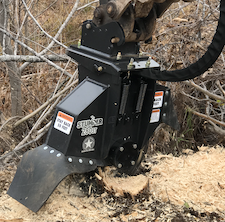 |
| Stumper Industries and other manufacturers look to design products that match the specifications and auxiliary power that are provided by the carrier machine without adding unnecessary weight or complexity. |
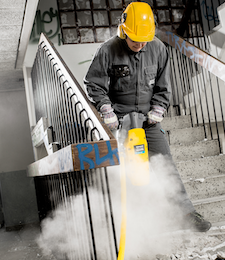 |
| The Atlas Copco RTEX breakers feature reduced weight, vibration and air consumption vs. other breakers within the Atlas Copco product line. The RTEX35 weighs 73.2 pounds while the Atlas Copco P90S counterpart weighs 95 pounds. |
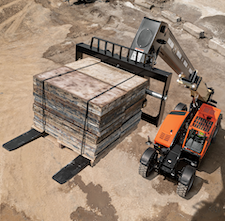 |
| Attachment advances that increase operator confidence and productivity, as well as drive safety improvements on job sites, are influencing attachment product development. |
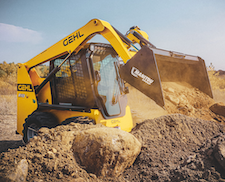 |
|
No matter what type of business, understanding your customer and competitive landscape is critical. Talk to your customers and show up on their job site; opportunity is there for discovery, says David Klaus at Manitou. |
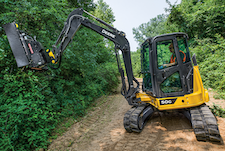 |
| Quality should always be a major factor when contemplating bringing on new equipment. High-quality attachments with the durability to last when faced with harsh conditions will help limit downtime. |
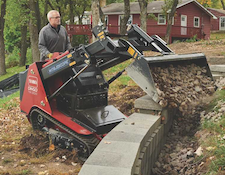 |
| The most enticing characteristic of compact utility loaders is their versatility. Depending on the manufacturers, users can turn them into virtually any machine by switching out the attachment with one of many others. |
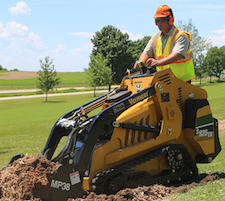 |
| Buckets are the most widely used attachment by professionals on mini skid steer loaders, but rental stores should keep in mind that buckets come in several shapes and sizes. |
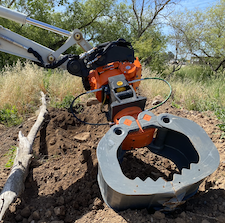 |
| Werk-Brau’s tilt rotator can improve the reach and productivity of grapples and other attachments. |
 |
|
SCOTT MOORMAN |
Higher expectations from attachments
Expectations have risen very rapidly in recent years for attachments. Twenty years ago, the idea of a “quick attach” for snowplows was very new with many existing systems requiring extensive work to align and put pins in place.
We’ve seen a movement to increasingly simple mounts that are designed to be used by just about anyone without a lot of effort or alignment to install it. The market continues to request easier attachment methods.
The “perfect” plow would be the one that reaches out and puts itself on your vehicle. Plausible or not, that’s what users want; they want to be able to just grab their plow and go to work. And when they are done, they want to easily remove it.
Electrical connections are similar to the demands of mechanical connections. We’ve seen expectations go up because users don’t want to have to think much about it; they want uncomplicated, reliable plug-and-play solutions.
Although many users are good about maintenance, the reality is, especially in the rental market, some professionals and weekend warriors are not going to take care of equipment in the same way. So, manufacturers need to respond by making equipment simple, error proof, low maintenance and robust.
Any time you attach equipment to a vehicle, you want the attachment to complement the vehicle and ideally have no negative impact on the vehicle that could potentially compromise your vehicle’s warranty or impede its function.
Rental centers should consider the universality of attachments that they are bringing into their rental fleets. Rather than carrying eight different coupling options, the more universal the equipment is, the better.
Skid steer attachments fall into this category, as the SAE J/ISO 6165 standard has been adopted to reflect the “quick-tach” coupler profile already used on most brands. Buyers Products’ customers have no issues connecting attachments to any popular skid steer brand.
Buyers Products’ larger pusher boxes are designed to be mounted on the buckets of larger machinery with chains using a simple and robust mounting mechanism that is universal, making it unnecessary for rental centers to carry a variety of couplers required by each different brand of machinery.
Rental centers can offer equipment with simple and robust attachment options so that operators who are not highly trained can easily use the equipment without damaging it. Being in a rental environment, equipment attachments will be installed and removed more frequently than if the equipment were privately owned by a contractor, which will contribute to more wear and tear.
Rental equipment may not be particularly well treated while in use, so rental centers need quality equipment that is simple and low maintenance to help keep the equipment in rotation without needing to repair or replace it which helps increase ROI.
Also, if users rent equipment that’s easy to operate and hard to damage, they will naturally develop a comfort level with the equipment, making it more likely that they keep coming back.
 |
| AMALIJA KOPAC Product Manager Genie |
Attachments expand versatility
One of the reasons telehandlers are often one of the first machines on a job site and the last to leave, is their versatility. Attachments, which allow one machine to perform several different tasks, contribute to that.
Equipment owners, however, don’t necessarily want to purchase the same attachment for every model in the fleet. This is particularly true for more specialized attachments, such as truss booms and buckets. Having attachments that can work with multiple models in a fleet is certainly important.
Genie works to meet this need by standardizing attachment points and then developing attachments that can be used across multiple models in the Genie GTH telehandler product family. For example, many of Genie’s most popular attachments, such as standard swing-and-rotate carriages, can be shared across the Genie GTH-636 and GTH-844 telehandlers. At the same time, forks can be shared across any model. The Genie Quick Attach system makes it easy and fast for equipment owners to change attachments.
Genie equipment developers continue to develop new attachments and new telehandler models. In that process, they look at opportunities to increase parts commonality and make it even easier to share attachments across a fleet.
At the same time, equipment owners also need attachments that are extremely durable because job sites can be very tough on telehandler attachments. Genie attachments undergo a rigorous testing process, like Genie machines endure, to assure Genie attachments can handle the demands placed on them on the job.
The decision about which attachments to add to a rental fleet should be based on customers’ job site needs and the rental center’s business goals. Is the rental center’s goal to add attachments to be competitive in the local market? Or to differentiate itself from the competition? Attachments can help do either or both of these things.
For example, if the rental center wants to go after the oil and gas market, managers may want to add a grapple attachment to the fleet to help efficiently move large pipes. If it is competing in a market whose customers are primarily in construction, the rental center might want to add swing carriages, which can help trades like framers and drywallers better lift and position loads.
Different trades need different attachments based on the work they are doing. Masons, for example, generally needs narrow forks and a narrow carriage, whereas framers are better served by a wide carriage and wider fork. Roofers, by comparison, often need a trash hopper or bucket in addition to the standard carriage and forks.
By understanding customers’ unique needs, and then stocking the right attachments, rental centers can help customers increase their productivity and efficiency and increase demand for their telehandlers in the process. Rental centers can also increase ROI by making sure they have a fleet designed to share attachments across multiple machines and models, thereby simplifying inventory and ensuring flexibility to meet customers’ specific application needs
 |
| JAY ROSENLUND Vice President of Sales Stumper Industries |
Simple, reliable attachments mean high ROI
With carrier machine advances happening frequently, attachments also need to be improved to ensure proper compatibility, performance and safety, while matching but not exceeding the carrier’s capabilities.
As flow and pressure rates increase, as well as load-sensing hydraulics and telematics being added or changed on the carrier machines often, customers are looking for equipment that is properly designed, easy to use, and productive. Stumper Industries and other manufacturers look to meet the advances and needs by designing products that match the specifications and auxiliary power that are provided by the carrier machine without adding unnecessary weight or complexity. For example, when the correct Stumper grinder is properly matched to the carrier, the customer will experience a productive and safe grinding operation.
Rental companies have many pieces and brands of equipment that need to work together seamlessly to ensure the customer is getting a safe and productive attachment. Stumper operates and tests its units on many different brands of equipment so rental companies can be confident when these units are brought into their rental fleet, they will be delivering to their customers a proven, safe and productive attachment that will make the customer happy and the rental company profitable.
One of the things rental companies may want to consider when bringing on new attachments is will it work well and seamlessly on most or all the fleet or will one or two machines need to be set up and dedicated to the attachment. Stumper grinders are simple to hook up and operate, which is ideal for both the renter and the rental house.
A rental company will want to explore the attachments they are looking to purchase and see if they will be needing any additional items such as wiring harnesses or case drains and if any parts or labor will be required to upfit their existing carrier machine fleet to properly operate the attachment. This can add more setup labor and cost. Rental centers might think about how trouble-free it is to hook up the attachment to any machine in the fleet and how easy or complex it is to use. Will the attachment be easy for the customers to understand and will they be able to operate them safely and productively?
Stumper addresses some of these challenges by not requiring any electrical connections and in most cases, no case drain is needed for operation.
Rental centers can help increase demand by understanding the customer’s project scope and making them aware of the attachment available. Often, the customer may not know that a certain tool or attachment was even an option for specific jobs. As rental centers support many different customers with a broad range of experience, from beginner to expert, it can be a win when an attachment can be offered that is easy to use for the beginner and well-liked by the experienced operator. Stumper provides a grinder that is easy to hook up and is easy to operate, which is appreciated by a wide range of customers.
Rental houses can improve their ROI in many cases by choosing the right attachment that will have a high utilization rate when paired with existing fleet equipment. It is always key to consider what parts and or consumables and what quantities will be required to be stocked for any given attachment. The lower number of parts needed, the better the ROI can be. Simple, high-performance attachments can help to reduce complexity for both the rental house and customer.
 |
| WILL MAZUREK Product Marketing Manager, High Pressure Air Atlas Copco |
Correct sizing can save money
Many companies are looking for user friendliness to add to their product design. For example, the Atlas Copco RTEX breakers feature reduced weight, vibration and air consumption vs. other breakers within the Atlas Copco product line.
The operator advances lead to more productive operator hours and less air consumed for the same tasks, while offering fuel savings. When compared with the Atlas Copco TEX-PS Series, the RTEX breakers feature a piston redesign that reduces air consumption and vibration for operator safety.
The physical weight difference is also significant, especially over extended use. The RTEX35 weighs 73.2 pounds while the P90S counterpart weighs 95 pounds. Even though both products offer the same reliable performance, the advanced piston redesign differentiates the Atlas Copco RTEX attachments.
There are two considerations that come to mind when bringing attachments into rental fleets. The first being the specific application where the tool will be working. Will there be access for a compressor? That determines the pneumatic attachments available for the job. Is the job site extremely remote? Consider a gas-driven tool attachment vs. a pneumatic tool in remote locations. Does the job need to be completed with a compact footprint? Look to utilizing a hydraulic power pack and tool vs. an air compressor. The first would be an ideal choice for confined or urban job sites.
The second consideration is customer make up. Are there existing or potential customers already utilizing hydraulic equipment that could also power hydraulic tools? Or are these customers already using pneumatic tools? The difference determines the capabilities of the attachments needed for the job.
Rental centers can look to products that can run multiple tools simultaneously. Because the RTEX breakers consume less air, rental centers can run multiple tools with a smaller air compressor, providing fuel savings. If the renter wants to operate two tools at once, the air compressor may need to be upsized to a unit that can produce more volume, but keep in mind that it could also lead to higher fuel costs. Instead, if two RTEX25 breakers are used, that pair can be powered with a 110-class compressor instead of a 188-class compressor.
The ability to utilize multiple attachments on one unit can optimize rental fleet usage and can increase rental center ROI. If rental houses are better able to match the compressor and tool to the application, savings can be realized by the end user and rental houses can reserve the larger compressor for applications that require it.
 |
| REBECCA YATES Product Marketing Manager JCB |
ROI, attachments and understanding
Equipment operators face unique tasks and obstacles on job sites; having to decide what equipment to use should be a non-issue.
JCB’s culture of never being content naturally told equipment developers that JCB could offer better efficiency with its purpose-built machines. Just look at the JCB Tool Carrier telehandler’s ability to use both a bucket and forks to enable customers to work smarter with multi-function attachments.
With the need for efficiency, JCB equipment can utilize attachments with RFID tags that provide the operator with specs on the attachment. An attachment with an RFID tag can be read by JCB’s rotating telehandler and will capture and send capacity and functional details to an in-cab display for quick access by the operator.
With technology inundating every aspect of our world, it only made sense to offer operators detailed information at their fingertips to ensure safe handling and functional information for niche applications.
Before bringing a new attachment into a rental fleet, take stock of the present fleet and understand which attachments are expected as part of a standard machine rental. For example, renters expect a telehandler to be outfitted with a carriage and forks and a skid steer will come with a bucket. This seems intuitive, but these attachments should be included in your overall machine rental price. If not, the additional price should be considered when determining your rental rates.
Second, plan the use of the attachment as best you can. It’s always cheaper, easier and creates a better relationship with your customer when salespeople recommend the right machine with multiple attachments the first time. Attachments can be used on multiple machines and models, which means you don’t need every SKU.
Machines are limited by the lowest common capacity; consider a telehandler that has a carriage with a capacity of 12,000 pounds. That attachment could be used on a smaller model machine with no performance loss.
Third, consider the expected uptake of the attachment. Is it specialized? Can it be added to the rental rate separately? If so, the item can be depreciated over time, which can impact ROI.
The reality is customers can choose any rental center for equipment. What differentiates your center? Hopefully, it’s the investment in your team. A quality team can set you up for success by knowing how to engage potential renters. Your team can bring to light areas the renter has not considered or can see the big picture and recommend different machine/attachment combinations to better complete the job. Once salespeople understand the job and specific needs, the team can upsell attachments that allow them to use a limited number of machines with diverse attachments for optimal efficiency.
Attachments are an investment and may not have been budgeted for in the renter’s budget. Revisit the job and see if there is another machine/attachment combination that would best complete the job while staying in budget.
Finally, ROI is based on the quality and longevity of the equipment. Protect your investment and care for the attachment like you would any of your machines. JCB attachments share the same purpose-built design that ensures durability to withstand the toughest sites because there is no room for downtime from an equipment issue.
 |
| JOHN BOEHME Senior Product Manager, Telehandlers JLG |
Productivity and safety drive attachment development
Attachments offer users flexibility on job sites, particularly when using lifting equipment like telehandlers — from picking and placing palletized loads to bucket work and suspending loads. Attachment advances that increase operator confidence and productivity, as well as drive safety improvements on job sites are influencing attachment product development.
That’s because there are always “jobs to be done,” and understanding job site challenges has led to the development of new features and functionality. JLG teams watch how telehandlers work on job sites, as well as talk with operators who use this type of equipment every day, ensuring that when JLG launches a product, it’s the right solution for our customers. Our innovations bring solutions to the market that solve these unmet needs.
Expanding the versatility of a rental machine such as a telehandler is all about the different types of attachments that can be used on the front of the machines. With fork-mounted, coupler-mounted and permanent-mounted attachment options, rental centers can rent telehandlers to do a myriad of tasks by simply changing the attachment.
For example, by switching out these tools, telehandlers can be used for more than just lifting applications. They excel at hoisting and material-handling tasks when equipped with a boom-mounted lifting lug attachment, which is also referred to as a hook or clevis. This type of attachment allows operators to put a chain or straps through it to efficiently handle suspended loads and hoist materials.
It’s important for rental centers to consider what attachments their customers need to complete the work. Telehandlers, for example, are called “tool carriers” for a reason — they can handle a wide range of hoisting and material-handling applications because of the large variety of attachments with which they can be equipped, from buckets, carriages and truss booms/lift hooks to specialty attachments like tire handlers.
Understanding the nature of the work to be accomplished and the capabilities of each type of attachment the machine can be fitted with is crucial to safe and efficient use. This means knowing whether a load needs to be picked or placed. Does the job require loose material to be scooped or a load suspended? Does the operator need to grapple loose material or pipes? Answering these questions will help rental centers guide their customers to select the appropriate size and type of attachments needed.
To use attachments most effectively, the machine operator needs to become familiar with each of the attachment options available to them. All attachments have a load chart and it is critical to refer to the attachment’s load chart before use. This will give owners and operators very important information about how the machine will operate with the specific tool attached, including details such as capacity and range of motion. To get the right machine to do the work, always read and understand the load chart associated with the machine and the attachment.
By matching the right attachment to the task at hand, users can maximize the benefits of the machine. For instance, telehandler attachments for handling suspended loads include jibs to give operators extra length and options for hoisting and handling materials that aren’t necessarily heavy but are big and bulky yet need to be set precisely. An example of this would be a truss boom attachment.
With attachments in a rental fleet, it is important for rental centers to understand the specific wants and needs of the local customer base. Knowing what’s important to the local customer base will help guide rental fleet purchases also help drive demand and increase ROI with their investments. For example, the rental center’s sales team must learn what the attachment and any associated technology has to offer their business but also how the same features benefit their customers’ businesses. Marketing these attachments and being able to effectively communicate the user benefits will positively impact utilization rates. The better job one does to communicate the advantages of the attachments, the more likely customers will be to request them, thereby accelerating the user adoption rate.
 |
| JASON SIMMONS Program Manager, Attachments John Deere |
Attachments drive automation
One of the top needs John Deere equipment developers consistently hear from customers is the lack of available labor and operator inexperience within the industry. John Deere is aiming to address these needs with attachments that increase capabilities and productivity on the job site. John Deere’s ever-expanding portfolio of attachment solutions are helping drive more automation onto the job site by offering products that make customers’ machines more productive.
To get more productivity from a skid steer, compact track loader (CTL), compact wheel loader or compact excavator, hook up one of the many easy-to-use attachments. The ever-expanding lineup offered by John Deere includes more than 100 models, so you’re sure to find the right tool for the job; they’re compatible with many comparable brands of machines, too. Each attachment is backed by the John Deere parts, service, and warranty coverage. Add an attachment, and watch your productivity instantly increase.
Not only does the addition of an attachment add versatility to your machine and increase efficiency on the job, but John Deere’s attachment technology allows operators to switch between attachments easily. For example, with the self-cleaning Quik-Tatch easy-attachment system, users can go from bucket to grapple in no time, significantly increasing productivity. Additionally, Angle-Tatch enables buckets, blades and other non-hydraulic attachments to rotate for more precise grading and leveling without operators having to leave the seat of the machine.
These models are designed to help customers get the most out of their investment with greater performance and increased efficiency when assisting operators on the job site.
When rental centers think about bringing on new attachment models into their rental fleets, they must prioritize time, versatility and quality. Time is money when operators are on a job site. Operators are always looking for equipment that will help get the job done faster while also limiting the amount of time needed to change attachments. Rental centers should gravitate toward attachments with quick coupler technology. Additionally, attachments that offer versatility are an attractive option for any operator. Operators are likely to gravitate toward renting an attachment that offers multiple functions to boost overall efficiency and convenience.
Lastly, quality should always be a major factor when contemplating bringing on new equipment. High-quality attachments with the durability to last when faced with harsh conditions will help limit maintenance downtime, assuring the job site is always running on schedule.
The first thing rental centers can do to increase demand for a given attachment is to make sure that it is configured to meet the needs of the market. Understanding the requirements of the local customer base, and then assembling a rental fleet based upon those needs will return the highest yield. John Deere equipment developers work hard to make its attachment offerings appealing to many users.
Using the recommended guidelines and adhering to the service intervals is key to getting the most out of your attachments.
 |
|
DAVID KLAUS |
Quality attachments yield happy customers
When it comes to the production of Manitou Group attachments, Manitou is making significant investments in robotic welders and nitrogen lasers that will reduce paint prep and finish time while increasing manufacturing efficiency. Manitou’s focus is on quality and the efficiency gained will be savings that can be passed on to the consumer.
Over the past year, it’s not uncommon to see competitors cheapen up products and simplify designs to offset rising costs. This comes solely at the expense of the customer. At Manitou Group, our products are our promise and that isn’t something we will be compromising.
When it comes to servicing rental customers, downtime is lost revenue, so Manitou Group attachments are engineered and tested day in and day out to prevent that. A good example is the Manitou dirt construction buckets built in Manitou’s Madison, South Dakota plant. They are made with grade 50 steel throughout and their wear bars are 8 inches wide. The fully welded side cutting edges climb all the way to one inch thick and the quick-attach upper brows are solid cast steel. Reinforcement plates and kicker plates further add rigidity and protection. Lastly, a seven-step cleaning and prep process is completed before applying an automotive-grade primer and paint finish. That’s why Manitou Group buckets last and still look good for years.
There is really no one answer that applies to rental centers looking to increase demand or increase ROI with these units. Rental centers come in all shapes and sizes, but there are patterns that are prevalent: customer convenience, general availability (especially this past year) and continual monitoring of competitive pricing are areas that need to be monitored closely. It they are not monitored, it costs rental center owners money.
Voice of the customer is a critical tool that Manitou equipment developers use to focus on needs, misses, improvements and opportunities that we have. No matter what type of business, understanding your customer and competitive landscape is critical. Talk to your customers and show up on their job site. Opportunity is there for discovery.
 |
| JAY THAKER Marketing Manager Toro |
Utility loader + attachments = improved efficiency
The most enticing characteristic of compact utility loaders (CUL) is their versatility. Depending on the manufacturers, users can turn them into virtually any machine by switching out the attachment with one of many others. There are massive benefits to having one machine on the job site that can do it all as opposed to five more specialized machines: transportation is easier, upfront costs are fewer and training is greatly reduced.
Toro is invested in developing attachments that are reliable, robust, easy to use and can also accomplish several tasks. While there will always be a need for specialized attachments, such as the new Toro floor scraper attachment, rental centers can benefit from investing in attachments that perform multiple tasks. For instance, a 4-in-1 bucket can function as a bucket, leveler, grapple or blade to accomplish multiple tasks without changing out the attachment. As Toro engineers look to design additional attachment options, this type of versatility is always top of mind.
The new floor scraper attachment, while specialized for flooring contractors, turns the electric-powered e-Dingo into a flooring removal machine. Users can then simply swap the attachment for a bucket to clean up. This is a great example of one machine, one job, multiple uses and increased utilization.
With more than 40 Toro attachment options from which to choose, deciding on the right one for a rental center can be overwhelming. Start by considering the types of jobs your customers primarily work on and ask a series of questions, including:
• What tasks do customers most often say they need to perform?
• Is there a certain lift height that’s most often requested?
• Do customers frequently express interest in hauling large amounts of material?
These types of questions will help identify which attachment(s) make the most sense to add to your fleet.
Commonly used attachments include the auger attachment for those in the fencing industry and the leveler, tiller and soil cultivator attachments for the landscaping industry; the grapple bucket, breaker and floor scraper are commonly used for the indoor construction industry. The most versatile attachment of all? The bucket attachment. It’s heavily relied on by many contractors in the construction and landscaping industries to handle large quantities of loose material.
Educating customers on the versatility of a compact utility loader with the right attachment is key and having several attachment options for different types of customers is essential. For example, a Toro Dingo, with the right attachments, can replace a dedicated floor scraper, trencher, tiller, auger and more.
Customers are looking for rental centers to be experts when it comes to equipment and best practices. Knowing the possibilities and limitations of attachment offerings is essential. CULs can instantly increase productivity of any yard project and with intuitive controls, can be operated by almost any homeowner. Ensuring customers are aware of the flexibility and ease of use of CULs and their attachments can increase demand, and ultimately ROI for the rental center.
Asking the right questions and encouraging the customer to be as transparent as possible when it comes to the specifics of his or her project can help build trust and match the right attachment to the job at hand. Listening to the customer and offering advice when appropriate will help the rental center to earn trust and encourage them to come back for any project they may be undertaking in the future.
 |
|
KYLE NEWENDORP |
Match the attachment to the job
On mini skid steer loaders, buckets are the most widely used attachment by professionals, but rental stores should keep in mind that buckets come in several shapes and sizes. For example, the Vermeer high-dump bucket is productive at dumping at higher heights and delivers quick dump speeds when compared with a standard bucket.
Beyond buckets, there are several attachments rental stores should consider adding to their fleets. A set of pallet forks can help users move material around the job site, and a hardscape grapple can help minimize the labor of placing pavers, blocks and small boulders. Contractors may want to rent an auger attachment to help drill holes for footings, trees and bushes; a trencher attachment is handy for any type of irrigation work.
To determine what attachments to carry, rental store personnel need to think like a contractor. They should evaluate the type of work customers typically do with rental loaders and then ask, is there an attachment that can help them improve their operating efficiency?
Or, in some cases, they may need to ask if the attachment they are currently using is the best one for the task at hand. For example, should they use a set of forks to move material instead of a bucket?
Rental professionals should remember that just because an attachment may fit on a tool carrier doesn’t mean it’s designed to operate on a particular unit. It’s always a good idea to review what types of attachments manufacturers have authorized for usage on machines. This level of due diligence will help contractors get the best performance from the tool carriers and attachments.
 |
| ALEX ANDREWS Product Manager Werk-Brau |
Attachments can increase productivity
Customers are increasingly trying to convert their average machine into what could be called a “Swiss Army” machine. This means taking the average attachments that the machine is typically equipped with and taking them to the next level.
This can be as simple as purchasing a Progressive-Linkage (Pro-Link) hydraulic thumb to allow for more thumb rotation than an average main pin hydraulic thumb.
Every year brings new industry improvements and the hydraulically operated tilting/rotating TiltRotator couplers have become a leader in the pack.
Single handedly, the TiltRotators can significantly cut operation costs and improve job performance. While keeping the machine stationary, this unique coupler system allows the operator to maneuver attachments in ways that would require moving the machine two, three, four or more times to get in position to work.
With Werk-Brau’s D-Lock TiltRotator coupler system, paired with dedicated attachments such as grapples, grading beams, forks, grading buckets and other attachments, contractors can turn an everyday construction and demolition outfit into a leading-edge operation.
When thinking about adding attachments to any rental fleet, return on investment comes first to mind. Based on the costs involved in not only the machine itself, but the attachments paired with the machine, consider if the initial cost can be offset by higher rental rates and demand. Also, from the renter’s perspective, can the attachment achieve lower operating costs or improved job performance?
Rental centers can increase demand or increase ROI in the initial phase is to bring in a couple units. By having the unit equipped with Werk-Brau’s TiltRotator, it allows the renters to physically see it and test its capabilities.
Finally, social media is not going away, so using it to showcase the unit with video and photos can continue the momentum of attachment adoption. From the 50-degree tilt in each direction, the 360-degree rotation with a variety of paired attachments can show the D-Lock TiltRotator can be the solution for many future construction applications.
This article originally appeared in the November-December 2022 issue of Pro Contractor Rentals magazine. ©2022 Urbain Communications. All rights reserved.


